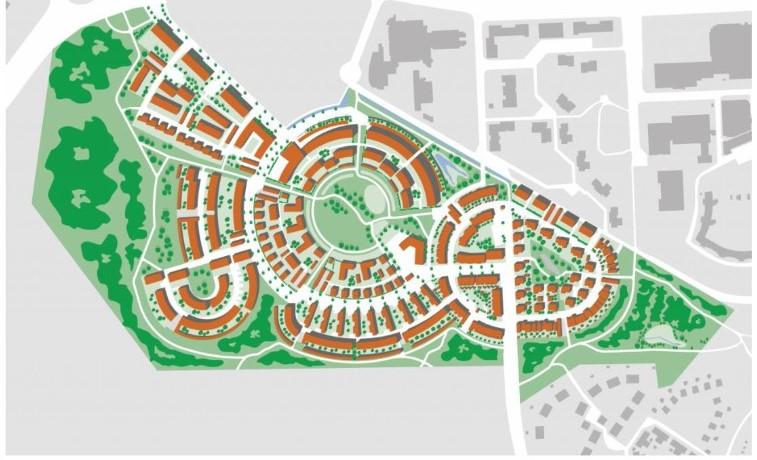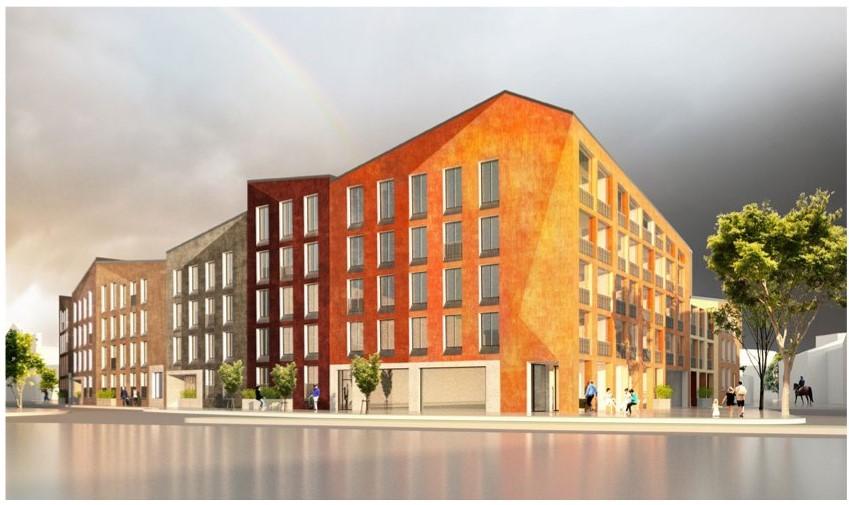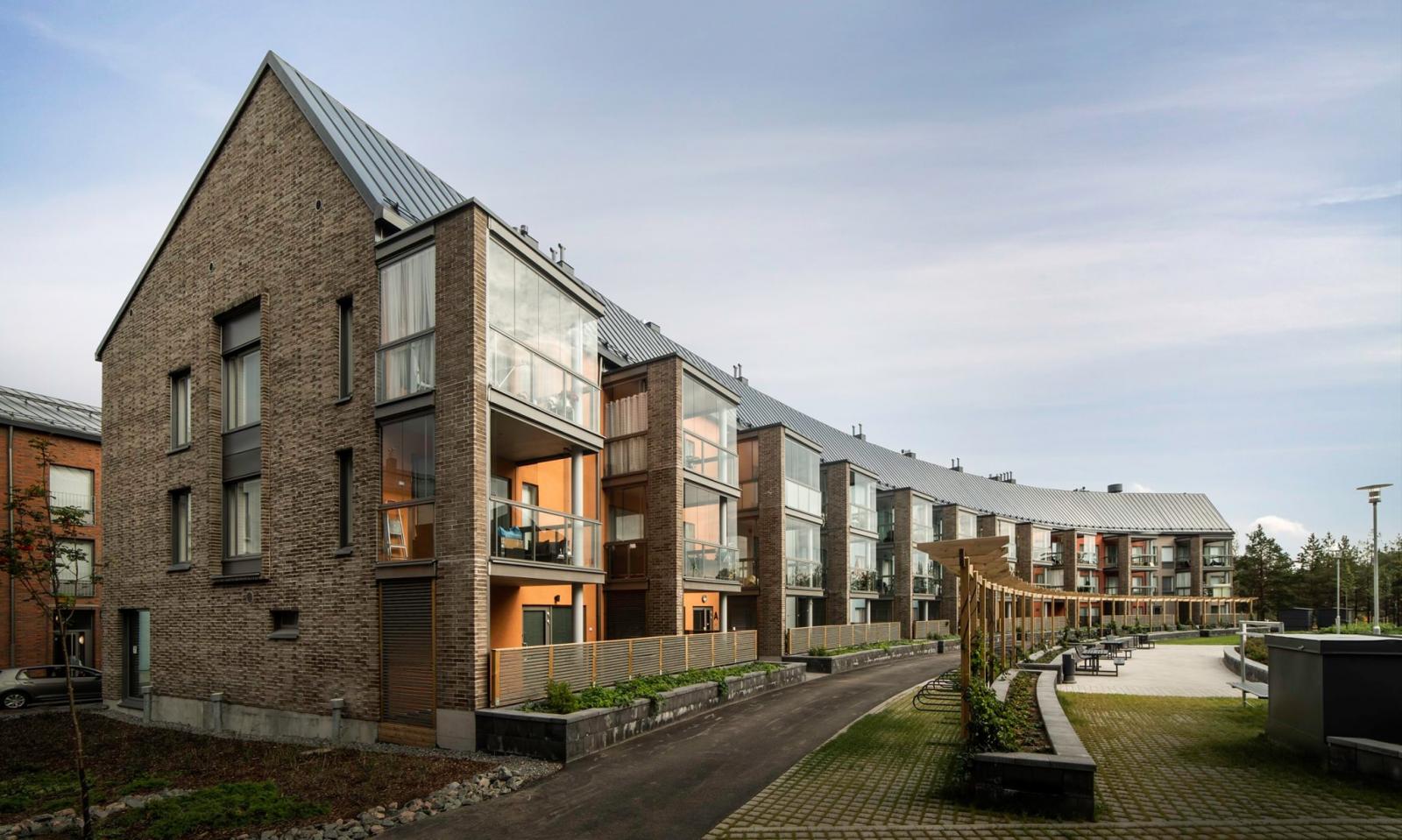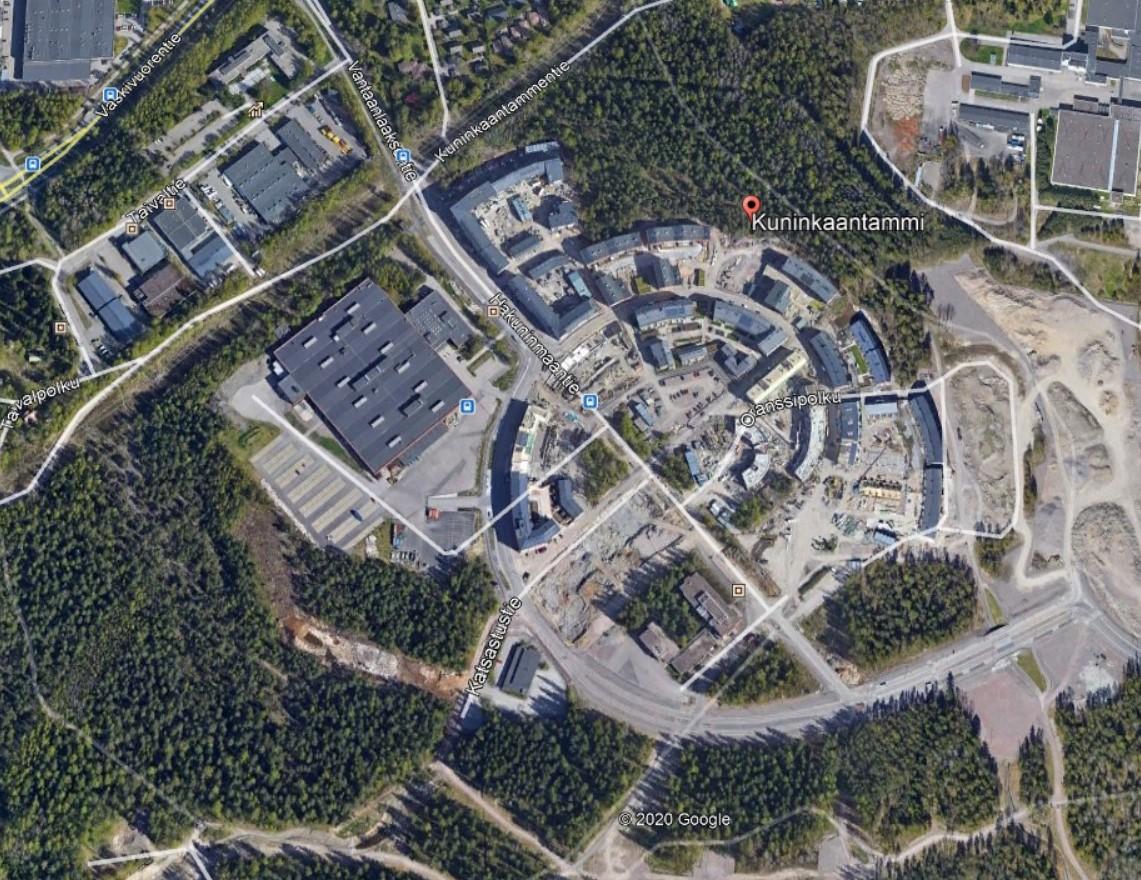Last updated: June 2024
Kuninkaantammi is a new energy- and eco-efficient residential district by the Vantaa River and Helsinki’s Central Park that is in the construction phase with a dense urban design, consistent with the ecological, experiential and community requirements of modern housing. It will become a climate-smart neighbourhood for 5,000 inhabitants. Environmental factors have already been noted in the zoning of the area, and energy efficiency guides the design and building processes. Kuninkaantammi will be a pilot project for stormwater runoff management in Helsinki using green infrastructure. The construction is ongoing (2013-2025). Management of storm waters in the area will be carried out through natural methods (ref. 1, 11).
Overview
Nature-based solution
- Blue infrastructure
- Lakes/ponds
- In-land wetlands, peatlands, swamps, and moors
- Community gardens and allotments
- Community gardens
- Green areas for water management
- Rain gardens
- Sustainable urban drainage systems
- Grey infrastructure featuring greens
- Alley or street trees and other street vegetation
- Nature on buildings (external)
- Green roofs
- Parks and urban forests
- Large urban parks or forests
Key challenges
- Climate action for adaptation, resilience and mitigation (SDG 13)
- Climate change adaptation
- Green space, habitats and biodiversity (SDG 15)
- Green space creation and/or management
- Regeneration, land-use and urban development
- Regulation of built environment
- Conversion of former industrial areas
- Water management (SDG 6)
- Flood protection
- Stormwater and rainfall management and storage
- Health and well-being (SDG 3)
- Creation of opportunities for recreation
- Social justice, cohesion and equity (SDG 10)
- Social cohesion
- Social interaction
- Sustainable consumption and production (SDG 12)
- Sustainable consumption
- Sustainable production
Focus
Creation of new green areas, Maintenance and management of urban nature existing green areas, Creation of semi-natural blue areas, Transformation of previously derelict areas
Project objectives
1. To create a residential district with a strong sense of community that is adapted for a changing climate and changing rain patterns.
2. The natural stormwater management methods will be visible in the area as technical solutions integrated with the urban landscape, such as various pools and stone streams along the streets, vegetation dents, large trees, green rooftops on the buildings and rain gardens on the plots. The most important goals of the various methods are to 1) utilize flow peaks, 2) decrease the total run-off and 3) potentially improve the water quality.
3. To promote a higher quality of life, including parks for leisure opportunities and an aesthetically pleasing district design (ref. 1).
4. To make energy- and eco-efficient residential area (ref. 11).
5. To combine an urban environment with a village atmosphere for the residents to have enhanced social livability (ref. 11).
6. Parts of the central park areas will be sectioned off for urban agriculture, and rain water will be used for irrigation. Courtyard areas will contain gardens irrigated with rainwater (ref. 13).
Implementation activities
1. Create ponds and open water flows to control the flow to the rainwater drainage and prevent flooding of the roads in the area;
2. Create stone streams along the streets;
3. Create vegetation dents;
4. Plant large trees, 5. Create green rooftops, 6. Create rain gardens, 7. Create infrastructure to lead the water to wetland park Helene Schjerfbeck Park, 8. To create dammed ponds in the wetland park where the water will be led before being channelled to Mätäjoki and Vantaanjoki, 9. To create retention ponds in green areas to filter out impurities from the stormwater to prevent disturbance of the EU protective species
(ref. 9, 10, 11,12, 13).
Climate-focused activities
Climate change adaptation:
- Implement sustainable urban drainage infrastructure (e.g. to make space for water)
- Renaturalization of rivers and other water bodies
Main beneficiaries
- Citizens or community groups
Governance
Management set-up
- Co-governance with government and non-government actors
Type of initiating organisation
- Local government/municipality
Participatory approaches/ community involvement
- Unknown
Details on the roles of the organisations involved in the project
Although the project is led by the government, the design is done by Jukka Turtiainen Arkkitehdit Oy (Ref 3). No further information was found on the detailed roles.
Project implemented in response to ...
... an EU policy or strategy?
Unknown
... a national policy or strategy?
Unknown
... a local policy or strategy?
Yes
(1. The City of Helsinki Storm Water Strategy has made drought management a priority (Ref 2, 3), 2. The Helsinki Metropolitan Area Climate Adaptation Strategy (Ref 6) stresses the importance of green spaces in urban areas to provide floodwater relief. )
Financing
Total cost
Unknown
Source(s) of funding
- Unknown
Type of funding
- Unknown
Non-financial contribution
Unknown
Impacts and Monitoring
Environmental impacts
- Water management and blue areas
- Improved water quality
- Increased protection against flooding
- Improved stormwater management
- Green space and habitat
- Promotion of naturalistic styles of landscape design for urban development
- Increased green space area
- Restoration of derelict areas
Economic impacts
- Other
Socio-cultural impacts
- Social justice and cohesion
- Improved social cohesion
- Improved liveability
- Improved access to urban green space
- Increased opportunities for social interaction
- Increased access to healthy/affordable food
- Health and wellbeing
- Gain in activities for recreation and exercise
Type of reported impacts
Expected impacts
Presence of formal monitoring system
Unknown
Presence of indicators used in reporting
No evidence in public records
Presence of monitoring/ evaluation reports
No evidence in public records
Availability of a web-based monitoring tool
No evidence in public records
References
1: Ilmastonkestävän kaupungin suunnitteluopas. (n.d.) Kuninkaantammi residential district is the Pilot of the Helsinki Storm Water Strategy. Available at: Source link (Accessed 22 July 2020)
2: Rakennusvirasto Byggnadskontoret. (2008). Helsingin kaupungin hulevesistrategia. Available on: Source link (Accessed 22 July 2020)
3: Helsingin kaupungin rakennusviraston julkaisut. (2007). Helsingin kaupungin luonnonhoidon linjaus. Available on: Source link (Accessed 22 July 2020)
4: Vierikko, K. & Fors, H. (2015). Helsinki, Finland: Case Study City Portrait; part of a GREEN SURGE study on urban green infrastructure planning and governance in 20 European cities. Available on: Source link (Accessed 22 July 2020)
5: HSY. 2012. Helsinki Metropolitan Area Climate Change Adaptation Strategy. Available on: Source link (Accessed 22 July 2020)
6: Helsingin kaupunki, Kaupunkisuunnitteluvirasto. 2016. Kuninkaantammi ja Honkasuo. Available on: Source link (Accessed 22 July 2020)
7: Uutta Helsinkiä. 2017. Kuninkaantammeen linnamainen ja vehreä keskuskortteli. Available on: Source link (Accessed 22 July 2020)
8: City of Helsinki Planning Department. (2013). Helsinki City Plan Vision 2050. Available on: Source link (Accessed 22 July 2020)
9: Suvi Tyynilä: Building green in Kuninkaantammi. (2016). SlideShare. Available on: Source link (Accessed 22 July 2020)
10: How Do We Adapt Our Cities to Water? (n.d.). Diva-Portal. Available on: Source link (Accessed 22 July 2020)
11. SWECO. (2019). Sweco architects design an ecological residential block for Kuninkaantammi. Available at: Source link (Accessed 19 August 2020)
12. City Panning Department. (2016). Kuninkaantammi and Honkasuo. Available at: Source link (Accessed 19 August 2020)
13. City Planning Department. (n.d.) Kuninkaantammi: Sustainable living by Central Park. Available at: Source link (Accessed 19 August 2020)
14. nternationales Holzbau-Forum. (2016). City of Helsinki as a Platform for Wood Construction Development. Available at: Source link (Accessed 19 August 2020)
15. Finland Art and Architecture. (2020). Available at: Source link (Accessed 19 August 2020)
2: Rakennusvirasto Byggnadskontoret. (2008). Helsingin kaupungin hulevesistrategia. Available on: Source link (Accessed 22 July 2020)
3: Helsingin kaupungin rakennusviraston julkaisut. (2007). Helsingin kaupungin luonnonhoidon linjaus. Available on: Source link (Accessed 22 July 2020)
4: Vierikko, K. & Fors, H. (2015). Helsinki, Finland: Case Study City Portrait; part of a GREEN SURGE study on urban green infrastructure planning and governance in 20 European cities. Available on: Source link (Accessed 22 July 2020)
5: HSY. 2012. Helsinki Metropolitan Area Climate Change Adaptation Strategy. Available on: Source link (Accessed 22 July 2020)
6: Helsingin kaupunki, Kaupunkisuunnitteluvirasto. 2016. Kuninkaantammi ja Honkasuo. Available on: Source link (Accessed 22 July 2020)
7: Uutta Helsinkiä. 2017. Kuninkaantammeen linnamainen ja vehreä keskuskortteli. Available on: Source link (Accessed 22 July 2020)
8: City of Helsinki Planning Department. (2013). Helsinki City Plan Vision 2050. Available on: Source link (Accessed 22 July 2020)
9: Suvi Tyynilä: Building green in Kuninkaantammi. (2016). SlideShare. Available on: Source link (Accessed 22 July 2020)
10: How Do We Adapt Our Cities to Water? (n.d.). Diva-Portal. Available on: Source link (Accessed 22 July 2020)
11. SWECO. (2019). Sweco architects design an ecological residential block for Kuninkaantammi. Available at: Source link (Accessed 19 August 2020)
12. City Panning Department. (2016). Kuninkaantammi and Honkasuo. Available at: Source link (Accessed 19 August 2020)
13. City Planning Department. (n.d.) Kuninkaantammi: Sustainable living by Central Park. Available at: Source link (Accessed 19 August 2020)
14. nternationales Holzbau-Forum. (2016). City of Helsinki as a Platform for Wood Construction Development. Available at: Source link (Accessed 19 August 2020)
15. Finland Art and Architecture. (2020). Available at: Source link (Accessed 19 August 2020)




